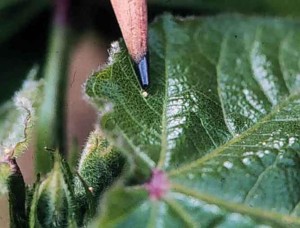Be Prepared to Spray Bollworm in Bt Cotton This Year- Change in Recommendation
go.ncsu.edu/readext?418539
en Español / em Português
El inglés es el idioma de control de esta página. En la medida en que haya algún conflicto entre la traducción al inglés y la traducción, el inglés prevalece.
Al hacer clic en el enlace de traducción se activa un servicio de traducción gratuito para convertir la página al español. Al igual que con cualquier traducción por Internet, la conversión no es sensible al contexto y puede que no traduzca el texto en su significado original. NC State Extension no garantiza la exactitud del texto traducido. Por favor, tenga en cuenta que algunas aplicaciones y/o servicios pueden no funcionar como se espera cuando se traducen.
Português
Inglês é o idioma de controle desta página. Na medida que haja algum conflito entre o texto original em Inglês e a tradução, o Inglês prevalece.
Ao clicar no link de tradução, um serviço gratuito de tradução será ativado para converter a página para o Português. Como em qualquer tradução pela internet, a conversão não é sensivel ao contexto e pode não ocorrer a tradução para o significado orginal. O serviço de Extensão da Carolina do Norte (NC State Extension) não garante a exatidão do texto traduzido. Por favor, observe que algumas funções ou serviços podem não funcionar como esperado após a tradução.
English
English is the controlling language of this page. To the extent there is any conflict between the English text and the translation, English controls.
Clicking on the translation link activates a free translation service to convert the page to Spanish. As with any Internet translation, the conversion is not context-sensitive and may not translate the text to its original meaning. NC State Extension does not guarantee the accuracy of the translated text. Please note that some applications and/or services may not function as expected when translated.
Collapse ▲As noted in this complementary article, bollworm populations have been heavy this year in corn and they are breaking through a lot of Bt corn. What that means for cotton growers is that they need to be prepared to spray overtop of some Bt cotton this year, especially Phytogen (WideStrike) varieties. Timing and spray chemistry is critical to maximizing yield. The recommendation below only applies to North Carolina during 2016 and is the result of conversations with previous NCSU entomologists Jack Bacheler, John Van Duyn, and JR Bradley, as well as Midsouth university Extension entomologists.
Our usual threshold for Bt cotton is based on larval sampling from fruiting tissues (see NC Cotton Insect Scouting Guide). Entomologists from the Midsouth recognized that certain Bt cotton varieties could benefit from an overspray of an insecticide with the active ingredient chlorantraniliprole (Prevathon). Some benefits this insecticide provides are a long residual, the ability to move to growing tissues, and specificity for caterpillars, including bollworm. They also found more benefit to spraying WideStrike cotton, compared to Bollgard II, TwinLink, or WideStrike 3. They also found that chlorantraniliprole only provided this benefit when 1) bollworm was present in large numbers and 2) when it was sprayed before larvae were present, in contrast to the NC threshold recommending sprays based on larval presence.
In North Carolina during 2013, we sprayed WideStrike cotton (PHY 499) with a high rate of Prevathon (27 oz) at bollworm threshold in replicated fields and compared them to replicated unsprayed fields. Populations continued to exceed threshold in untreated plots and bollworm injury was higher in unsprayed compared to sprayed plots. Yields were different by only one lb. During 2014, we repeated the experiment, but sprayed when bollworm had laid eggs and before larvae had hatched. Even though populations and injury were similar between 2013 and 2014, yield was higher by 90 lbs. in the sprayed plots.
Recommendation for 2016:
If you have WideStrike cotton (generally Phytogen varieties besides PHY 495), begin scouting cotton terminals, leaves, and fruiting structures for bollworm eggs starting mid-July. Eggs are small and take a sharp eye to spot. Unfortunately bollworm and tobacco budworm (100% controlled by all Bt cotton) eggs are difficult to tell apart. However, bollworm has been much more abundant than tobacco budworm this year so to play it safe, assume it’s a bollworm egg. Eggs can be laid on any plant part, but whole plant samples can be challenging. Therefore, an alternative would be to see there are 25 eggs on 100 terminals, stems, or fruit (squares/blooms/bloom tags/bolls); if stink bugs or plant bugs are not an issue, apply Prevathon. If there are 25 eggs on 100 terminals, stems, or fruit (squares/blooms/bloom tags/bolls), and if stink bugs or plant bugs are an issue, apply Besiege (note that this will kill more beneficials compared to Prevathon). Do not use this strategy if eggs have hatched and live larvae are present- use the threshold below.
If you have Bollgard II, PHY 495, TwinLink, or WideStrike 3 cotton, only apply insecticide when thresholds are reached (three 2nd stage bollworm (or larger) in 100 fruiting tissues on one scouting trip, two 2nd stage bollworm (or larger) in 100 fruiting tissues on two consecutive scouting trips, or one 2nd stage bollworm (or larger) in 100 fruiting tissues on three consecutive scouting trips). You could use any of the insecticides noted for bollworm control in the 2016 NC Ag Chem Manual (page 80). Also note that areas where plant bugs are being sprayed may catch some relief from bollworms, as some insecticides targeted for these insects will pick up some bollworms.



